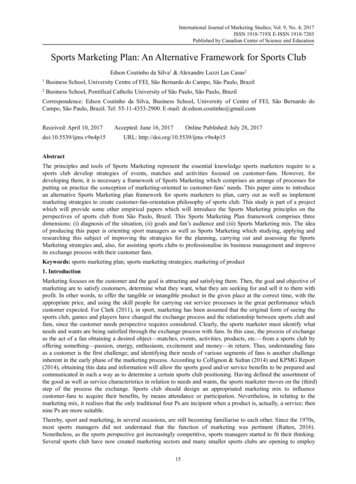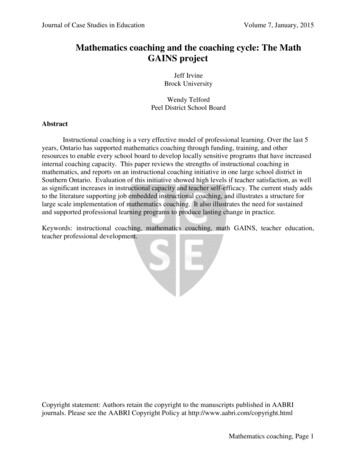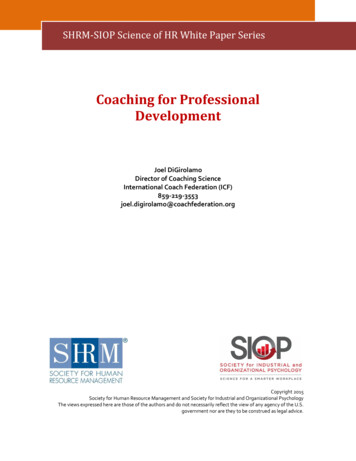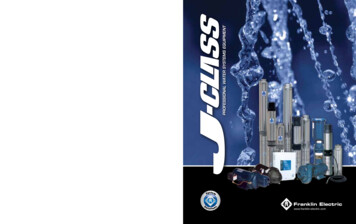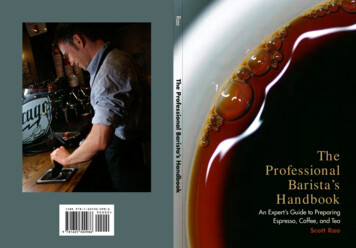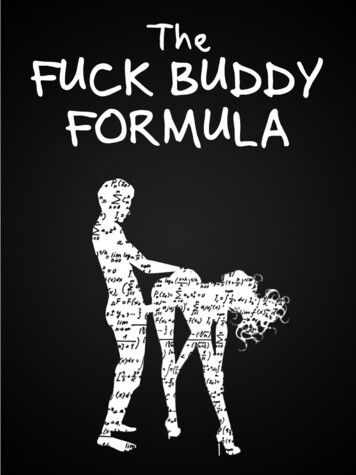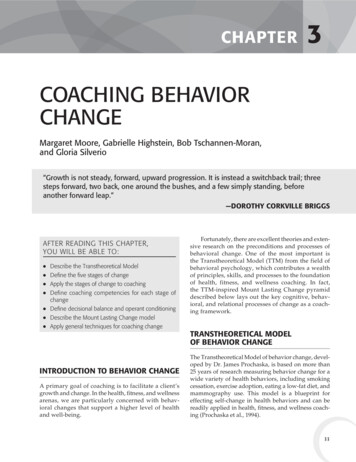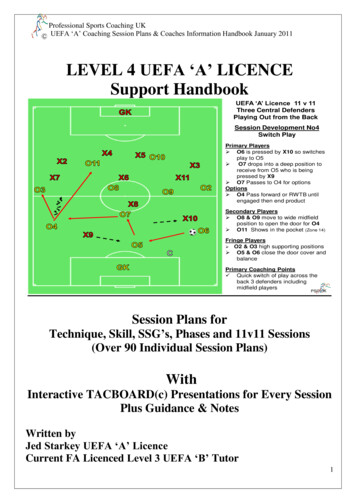
Transcription
Professional Sports Coaching UKUEFA „A‟ Coaching Session Plans & Coaches Information Handbook January 2011LEVEL 4 UEFA ‘A’ LICENCESupport HandbookUEFA ‘A’ Licence 11 v 11Three Central DefendersPlaying Out from the BackSession Development No4Switch PlayPrimary Players O6 is pressed by X10 so switchesplay to O5 O7 drops into a deep position toreceive from O5 who is beingpressed by X9 O7 Passes to O4 for optionsOptions O4 Pass forward or RWTB untilengaged then end productSecondary Players O8 & O9 move to wide midfieldposition to open the door for O4 O11 Shows in the pocket (Zone 14)Fringe Players O2 & O3 high supporting positions O5 & O6 close the door cover andbalancePrimary Coaching Points Quick switch of play across theback 3 defenders includingmidfield playersPSC UKSession Plans forTechnique, Skill, SSG’s, Phases and 11v11 Sessions(Over 90 Individual Session Plans)WithInteractive TACBOARD(c) Presentations for Every SessionPlus Guidance & NotesWritten byJed Starkey UEFA ‘A’ LicenceCurrent FA Licenced Level 3 UEFA ‘B’ Tutor1
Professional Sports Coaching UKUEFA „A‟ Coaching Session Plans & Coaches Information Handbook January 2011FA LEVEL 4 UEFA ‘A’SESSION PLANS & GUIDANCEForward from: Jed Starkey UEFA ‘A’ & Current FA Level 3 TutorThank you for buying this resource provided by a current UEFA ‘A’ Licence and FALicenced Tutor. I can assure you that the following handbook and CD(r) containing fullcolour session plans, combined with the Interactive TACBOARD Presentations andsupporting information will definitely develop your knowledge of the coaching processand delivery at Level 4 UEFA „A‟ Licence.The aim of this resource is not designed to contradict what you have developed on anyFA course you may have attended or what any other tutor has taught you, but designedto assist your development at club level or prepare you for a future „A‟ licence courseor refresher maybe. The resource covers the principles of attack and defence with indepth information and session plans to develop you knowledge on and off the pitch to„A‟ Licence standard.The session plans are comprehensive with information on Technique to Functions, toSSG‟s on to Phases of Play and then a 11v11 game. The combination play forexamples has 8 variations and 18 slides of information. In addition there are alsoindividual functions, phases & 11v11sThere is also a BONUS section with 9 UEFA „B‟ Session Plans for those times whereyou do not have all your players also Speed & Agility and Warm Up sessionsBy using the information, TACBOARD(c) and session plans provided as a learningtool, you will be able to develop your own ideas and future session plans. The plansprovided in this resources show start points, varied scenarios, progressions, playermovement, session developments, who, where and what to coach with suggestedcoaching points and tips from a current FA Tutor. Please remember that the CD (R)has a massive amount t of information on it so please give it time to load onto yoursystemEnjoy the ResourceJed Starkey - UEFA ‘A’ Licence & FA Level 3 Licenced Tutor2
Professional Sports Coaching UKUEFA „A‟ Coaching Session Plans & Coaches Information Handbook January 2011InformationPageHow to use the Powerpoint SlidesKey Phrases at Level 4 UEFA „A‟Game TransitionPassing PrioritiesGood Session planning at UEFA „A‟ LevelConsideration for AssessmentsStart PointsFree PlayWho What and Where to CoachGood Delivery PlanningSet Play PlanningHydration for SportBonus CD Content45-8910-11121314-161718192021-2223(UEFA „B‟) SessionsUEFA ‘A’ Session Plans24 ONWARDSSection No1 - UEFA ‘A’ Licence Set Play Session plansPage 25-26Page 27-28Page 29Page 30Attacking Corners (Variations)Defending Corners (Variations)Attacking Free Kicks (Variations)Defending Free Kicks (Variations)Section No2 - UEFA ‘A’ Licence SSG to Phase to 11v11 Game Session planPage 31-32 Defending, Marking, Covering and TrackingSection No3 - UEFA ‘A’ Licence Function to Phase to 11v11 Game Session plansPage 33-35Page 36-38Page 39-41Forward Runs with the Ball to Create and Exploit SpaceCombination Play in the Attacking ThirdPlaying Out from the Defensive ThirdSection No4 - UEFA ‘A’ Licence Phase of Play Session plansPagePagePagePage42434445Playing Out form the Defensive ThirdGoalkeeping Support PlayBack 4 Defenders Dealing with Direct PlayGK and Defence on Being More Effective on Dealing with Crosses.Section No5 - UEFA ‘A’ Licence Function Session plansPage 46Page 47-48Page 49Central Defenders Passing to StrikersMidfield Players Support Play and Passing Positively2 Central Defenders How To Defend in Central AreasSection No6 - UEFA ‘A’ Licence 11v11 Game Session Runs Off the Ball, Overlapping & DiagonalThree Central Defenders Playing Out form the BackThe Shadow Striker (Zone 14 player)Defending Ready to Counter Attack (On the CD)Attacks from Wide Areas (6 options)Section No7 – Skills SectionPage 63 -64 Defending Set Plays3
Professional Sports Coaching UKUEFA „A‟ Coaching Session Plans & Coaches Information Handbook January 2011TACBOARD(C) PRESENTATIONSEach presentation is designed to provide interactive information for you toassess and then use. You can move the players around to suit your sessionas you see fit.Each presentation shows, set up, player and pass movement, progressionsand who, what and where to coach with specific coaching informationon Primary, Secondary and Fringe playersProcedure for playing presentations;1. Put the CD in the PC2. Open PowerPoint Point Software3. Click slide show4. Click View Show5. Let the show role6. Slides will rotate everytime you press the downarrow and will gobackwards on the uparrow7. You can stop the show atany time and goback/forward using yourup and down arrows atany time.4
Professional Sports Coaching UKUEFA „A‟ Coaching Session Plans & Coaches Information Handbook January 2011KEY PHRASES AT LEVEL 4 UEFA ‘A’PRINCIPALS OF PLAYCollective A group of components/comments/information used to aid attack anddefenceAttackingDispersal – on winning possession obtain width and depth, stretch your opponentsand create, maintain and exploit space.Support – ahead, alongside and behind the ball, angles, distance, timing,fundamentals inter changekey to possessionPenetration – exploit space with good movement with and without the ball,use of possession to an outcomeFlair – individual, be inventive, produce the unexpected, run, change of pace, firsttouch, dribble, combinationCentral Attacking PlayCentral Approach Play – Players Movement – Successful teams keep the ballmoving. Barcelona completed 900 passes against Real, why? ForwardsPositive attacking playAngles, distance, timingBody shape to ReceiveFeet, body-shape, awareness1st Touch forward – let the ball runDeceive as you receiveWillingness to passMove the play forwardPass forward and supporto Behind the defenceo Alongside the defenceo Into and through the defence5
Professional Sports Coaching UKUEFA „A‟ Coaching Session Plans & Coaches Information Handbook January 2011Be a pass receiver Behind the defenceAlongside the defenceIn front of the defenceAhead of the ball (locally)DefendingWhen -does defending it commence, transition, handover of possession ( thewill and team desire to defend)Where -does defending commence, any area of the pitch (game plan). Firstaggressive triggerHow -does defending commence (areas and circumstances?).Triggered by first defenderBall surrenderedCircumstances of possession lostBall intercepted – we recover – urgencyBall out of play – pressure – outnumbered - withdrawWhat - is involved in defending Depth – no pressure on the ball reduce space behind to reduce opportunities Delay – especially when outnumbered allow team to reshape, reduce time andspace Deny – opponents space and time to develop play, protection of high priorityareas Compactness – achieved on a trigger at a given point to stop opponentsplaying with their heads up, man to man – eliminate key players Concentration – a collective of players who can overload the ball Predictability – manoeuvre opponents into areas where play becomespredictable, Channel or deflect attacking play, Deflection of opponents attackinto well defended or less important areas depending on circumstance Balance – must be achieved behind the ball to stop opponents’ penetrating,covering spaces critical to your opponents6
Professional Sports Coaching UKUEFA „A‟ Coaching Session Plans & Coaches Information Handbook January 2011OTHER KEY PHRASESOther key phrases that you could master which would impress any assessor, coach or playermay be;Game Planning1. Tactics/Game Plana. 4-4-2 4-1-4-1 formations for that specific game or your styleb. Drop deep and soak pressure in the first half and then attack in the second halfmaybe2. Strategy – How you wish to play over a season, may be a counter attack team3. Game Organisationa. Every player knows what their job is on corners for and againstb. Who takes corners, free kicks and throw in‟sc. Where the keeper will kick goal kicks to4. Zonal – Marking or attacking through specific areas to create or deny attackingopportunities5. Patterns of Play – Planned and practiced variations on specific movement of playersand the ball at specific times and moments in the game. Players knowing what to dowhenIn Attack1. On the shoulder of the last defender, stood close to him but not offside2. Off the shoulder (in line with him but not stood next to him maybe at anadvantageous position maybe see his shirt number ready to attack the space)3. Across the defender (strong run with blocking arm to block the defenders recovery)4. Attitude (to dribble, score, create space)5. Prime Target Area ( the second 6 yard box where the keeper will hesitate to comefor crosses)6. In the pocket – (Zone 14) the area where the striker drops off the defender towardsthe ball maybe just in front of the defending edge of the box7. End product – Shot, dribble or cross8. Mavericks – Players who operate in the final third of the pitch with intelligentmovement who can create special situations, movement and execution of endproducts9. Pinning the Defender - Centre forward making sure the defender cannot get aroundhim, sometimes the back to goal striker10.Play maker – The creative one11.Play Breaker – The ball winner7
Professional Sports Coaching UKUEFA „A‟ Coaching Session Plans & Coaches Information Handbook January 2011In Defence1. Switch on (when play changes hands)2. On the front foot (ready to intercept)3. Cover and balance (for units behind the ball)4. Check shoulders (for lateral cover and balance)5. Tracking players (see the player see the ball – the defensive triangle)6. Recovery runs (getting goal side for cover and balance)7. Narrow (towards your own goal)8. Attack the ball (heading)9. Press the ball and force the attacking player to make a decision10.Win it IF YOU CAN11.Do not dive in12.Do not give silly fouls away on the edge of our boxPressure on the BallWhen to Press and When to drop?You can only effectively push out from defence if you have effective pressure on the ball.If not the other team will play in behind you and exploit the space you are creating.The Questions may be;Q – On game transition can you win the ball immediately?A – Only if secure and the whole team is active Q - As a team can you engage the first aggressive trigger from the opposition?A - Press as a teamQ - If only 1 players can engageA - Drop and apply the principles of defenceQ – Defend the counterA – Concede ground and apply the principles of defence8
Professional Sports Coaching UKUEFA „A‟ Coaching Session Plans & Coaches Information Handbook January 2011a.GAME TRANSITIONThe 3 Moments in any game which a good coach will considerNext time you watch any game, do not follow the ball but watch what players/units/team dowhen play changes from team to team and from attack to defence. If you understand thesethree moments, you will be able to use terminology in the right context at the right time.There are basically three moments which happen hundreds of times every game, try and getyour analytical coaching mind to consider;1. What to do when you have the ball? (Create, maintain, exploit etc)2. What to do when play changes hands? (Switch on Re shape,)3. What to do when the opposition has the ball? (Press, drop, narrow delay, deny,deflect, dissect, defend etc)Technical & Skills PracticesAt „A‟ Licence Level there will be sessions that purely focus on technique (The how tosessions) and skill (Decision making when and where to). This may be completed in abasics 30x30 box however you can always adapt your knowledge from UEFA „B‟ sessionswhen you have new players or players who are younger and may struggle with the full „A‟Licence 11v11 session.Functional PracticeA practice situation from a snap shot (picture/scenario) from a live game you are planningin the near future or have played recently and need to work on. The aim is to work with aplayer or unit on their roles and responsibilities in a specific area of the pitch at certaintimes both in attack and defence. This is where and how you teach the full backs forexample how to play full back in both attack and defence.Small Sided Game (SSG 9v9)This game is directional similar to level 3 however with more players. An SSG is designedto develop unit and team understanding of the principles of attack & defence and thetransitional period mentioned above. Official game rules should apply such as offside todevelop timing of runs, and normal throw in‟s etc.Phase of Play 8v8 9v8 9v7This is where the coach really puts all the development aspects previously coached intoplay with a practice designed to develop unit and team tactical understanding on two thirdsof a pitch and full width. This practice rehearses the players in full movement and unitcohesion following the principles of play11v11 Full Practice GameDesigned as a full practice session and rehearsal for a match situation employing players intheir natural position and practicing full tactical analysis and planning match strategy9
Professional Sports Coaching UKUEFA „A‟ Coaching Session Plans & Coaches Information Handbook January 2011PASSING PRIORITIESMany teams work for hours on sessions that do not fully develop players understanding ofthe variation of passes and the decision making of what type of pass to use when.Following varying practices you will have coached the individual on his/her role in aspecific position, now coach the players on their decision making of where and when toselect a certain pass. The following list is a suggested guideline and is NOT THE LONGBALL GAME!Some schools of thought call this the priorities in passing or the passing checklist. If youwatch a premier League team when they re gain possession, where do they look to passfirst?1. Into space to exploit the last defender –a. When the opposition has pushed high up the field leaving a large space behindthe last defender (s)b. Not a straight pass but a pass delivered with quality that does not go through tothe keeper. (Practiced in a skills or functional practice)c. In wide areas to exploit the space left by the opposing full backs who mayhave pushed on in their attack. (Counter attack weaknesses in their defence)2. Into feet of the most forward player –a. Normally the central striker who is pinning the centre half or dropping off intothe pocket to receive (zone 14) which is a favourite play of Wayne Rooney3. Into wide areasa. To exploit space and encourage 1v1 situationsb. This can be done earlier of course depending on the4. Through Midfield or Holding up the playa. To draw defenders out of positionb. The back to goal strikerc. To release players from holding positionsd. To attack in central areas and overload defenders5. Switching Playa. When you need to change the point if attackb. When you have explored all impossibilities in that areac. To exploit a weakness in the opposition10
Professional Sports Coaching UKUEFA „A‟ Coaching Session Plans & Coaches Information Handbook January 2011MATCH SCENARIOS TO CONSIDERHave a think about the following scenarios/snap shots and put yourself in the players situation, what wouldyou do next (well that‟s what you coach him/her on)Scenario 1 – The Right back has intercepted the ball in his/her middle third just outside his/her own 18yard box?Transition – You have re gained possessionWhat should happen next – Your team starts the sequence following the attacking principles of play and„creates space as individuals to receive‟ and „units/team to create opportunities ahead of the ball‟Players Decision making on Passing Priorities for this scenario;1. Can he/she pass into the space behind the defenders so that striker or wingers can exploit the spacebehind the last defenders? The selection of the pass is crucial dependant on what part of the pitchhe/she intends to execute the pass. The pass must eliminate the defenders and not go through to thekeeper.2. Ball into feet of the striker dropping into the pocket (known as zone 14) so that support frommidfield may provide opportunities to create space by running at, or pass into space behind the lastdefenders?3. Ball wide to wingers when option 1 or 2 not on. Create space wide and opportunities to cross theball behind the line of last defenders.4. Short pass to midfield so that the receiving player can progress onto the next phase higher up thepitch.5. Pass laterally (switch play) as there is no player open for the pass, retain possession6. Pass backwards (switch play) as there are no other options, retain possession.Note that the current Premier League teams set counter attacking as a priority with long accurate balls overthe top or down the side of the last defender. If the ball is not accurate or of high quality then it‟s the longlaunch game we all hate.Notes on Passing Priorities1. If you coach that when play changes hands (as this is when the other team is at their weakest as theyhave been on the attack) your players should look to pass forward as quickly as possible, this is a level4 Session (Counter attacking) This session is coached extensively by Manchester United and Chelseaacademies and first team whom all adopt a quick counter attack when play changes hands. It will alsohave a time restriction for players to regain possession and complete an attack.2. The players should be coached in a variation of passes in a function such as;a. Ball over the top with back spin into space behind the last defenderb. Low swerved pass into the strikers feet on the run in behind last defenderc. Low driven ball which travel very quickly to its intended target.d. Short 10-15 yards passes with 1 and 2 touch of high quality.11
Professional Sports Coaching UKUEFA „A‟ Coaching Session Plans & Coaches Information Handbook January 2011GOOD SESSION PLANNING AT LEVEL 4 UEFA ‘A’I have assessed many coaches at level 3 whom all forget that the planning stage is fundamental to success.The plans you devise at your club are dependent on availability, age and ability of your players and will bemore relaxed where you can develop players and your own skills without pressure of time or assessment.On your assessment you will probably be under more pressure and coach the cohort from your course.Listed below are two variations that will assist you planningFail to Plan Plan to FailAT YOUR CLUBYou should use the match analysis skills you have developed over the course of training at UEFA „A‟ levelto determine what sessions/practices you wish to plan. I would suggest that you do not make every sessionan FA/UEFA session as this will bore the players with a “stop stand still” mentality. Let the game flowand use guided discovery more to engage the players with their understanding in units in real matchsituations.Focus on weaknesses and then plan a strategy of sessions such as skill/functional sessions maybe topractice units, then SSG‟s when numbers/attendance are low and Phases of Play or 11v11 with another agegroup prior to your next match.Let the players explore the snap shot scenarios/pictures you set them and see how they come up withanswers to the problem. If they cannot come up with an answer, then use you‟re coaching skills to step inand show them.ON YOUR ASSESSMENTRemember that the Assessor will be marking you on a points system.Your session planning is critical and sets the scene for your assessor. If the session plan looks scruffy,lacks detail and content then this will give the Tutor/Assessor the impression that your planning andpreparation is poor, so may the immanent session?Plan for your assessment as follows;1. Mark the pitch as per your plan, get rid of all other cones and kit etc so that the area lookprofessional, you look professional too!!2. Layout of your equipment for the session ready to play3. Start with a good brief using tactics boards (maybe)4. Get the players on the pitch and explain the area of play and the objectives for both teams5. Get them playing ASAP and have some free play.6. Your start point should develop from free play.7. Set pictures/scenarios from match situations for players to develop8. Stand in a GOOD COACHING POSITION where you can step in quickly!! You may be aroundthe play but not in the play as you will get in the way and not see all the pitch!9. Use the coaching formulae to correct faults but NOT ALL COMMAND10. Coach/effect all players Primary, Secondary and Fringe linking them THROUGH THETHIRDS with understanding. But remember that you will have up to 11 players to deal with so bequick, decisive and informative.11. Plan to have at least 10 minutes FREE PLAY to let the game flow.12
Professional Sports Coaching UKUEFA „A‟ Coaching Session Plans & Coaches Information Handbook January 2011CONSIDERATIONS FOR ASSESSMENTSAs a UEFA „A‟ Licence and a FA Tutor, I see so many coaches deemed not competent ontheir final assessment for the same reason. They cannot step in quickly enough and coachin open play when mistakes happen for real both on and off the ball, technically andtactically.I suggest the following strategy;1. Clearly explain the scenarios you are going to coach so that all players understandthe session and what they are going to achieve.2. Use tactics boards, or discussion to confirm understanding3. Reinforce the subject throughout the session to confirm player understanding!!!4. Rehearse and explain your demos so that you can show effective pictures.5. Do not watch the ball, observe the whole pitch as many coaches who fail justconcentrate on the area of the ball and forget cover and balance for example.6. Recreate the picture as effectively as possible as unrealistic pictures will causeunrealistic fault correction.7. Engage all players and units linking players where possible where possible withprime primary, secondary and fringe players being engaged in the picture you arecorrecting.8. DO NOT USE ALL COMMAND STYLE of coaching.9. When you go to free play, be quick to step in!!!!!! Use a whistle if you are not a loudcoach as the fault may be 50 yards away on the other side of the pitch.10.Use ‘Off side’ for realism13
Professional Sports Coaching UKUEFA „A‟ Coaching Session Plans & Coaches Information Handbook January 2011START POINTS Vs FREE PLAYAt levels 3 & 4 it essential that you get the start of the session right so that it buildsconfidence in your session, organises the players in realistic start positions and then sets thesession off on the right pathway to success. The best way to start a practice is with FREEPLAY as this is the most effective and realistic start which I am sure will get you to yourtopic within a minute or so. Its real so try it!!If you do have to use a start point it must be a realistic scenario from a real game situationwhich sets the scene for your topic to be successful. Over the past 15 years assessingcoaches, I have observed so many start points either be unrealistic, in the wrong area of thepitch, or most of all too complicated and therefore wastes time and causes problems for thecoach even before the session has fully started.Free Play at the Start of the SessionAt the start of a session let the players experience free play so that they can get a feel forthe game. I assure you that if you are observant and understand your SESSION AIMSfully, your session will be able to start from free play, let it happen naturally!!Structured StartsThe session plans and PowerPoint slides provide a variation of structured starts such as„takes‟ in midfield for attacking third topics, interceptions which can be used any where,and balls over hit into the keeper for sessions building from the back. You may of courseuse a variation of starts which you have observed or like such as throw in‟s free kicks andmistakes by players. These structured starts are real scenarios from game situations;Regardless of the choice of start for your session you MUST consider the following;1. The start is a controlled play which provides the ball to the team you wish to coach.2. Keep the start as simplistic as possible to ensure success as some players cannot hitdifficult balls to start the game and of course the session will get off on the wrongtrack, confusing players and frustrating you the coach!3. Make the structured start point you have chosen as REALISTIC as possible;a. Ensure it‟s in the part of the pitch where you want to start your session from.b. The players MUST be in realistic positions and moving as realistic as possiblefor that picture/scenario/snap shot from a real game which you have chosen foryour start point.c. DO NOT stack teams and make one team that dominant that the session onlyflows one way.d. Yes of course put players in realistic positions that they would play in or haveability in that area of the pitch however, ensure that if you working with awide player to deliver crosses then ensure the fill back can play realisticallyand defend well. This will challenge the wide player more.14
Professional Sports Coaching UKUEFA „A‟ Coaching Session Plans & Coaches Information Handbook January 2011START POINTSHave a look at the following four stat pointsThey are realistic, quick and get into your topic ASAPMidfield InterceptionGets the ball to theteam you arecoaching so that youcan get into yourtopic asap.This session isRWTB so you cansee O2 is now inpossession and canRWTB within 30seconds of the startof the sessionMidfield TakeUsed to move ateam to one sideof the pitch andthen switch playwide to the widemidfield player.Used in thissession forcrossing &finishing15
Professional Sports Coaching UKUEFA „A‟ Coaching Session Plans & Coaches Information Handbook January 2011Misplaced PassPHASE OF PLAYPlaying Out From theDefending ThirdSet upCoaches Team O’s GK-4-3- 1 (9)Xs 3-3-2 (8)Organisation The target player (T) can beused for both teams to recyclethe ball and keep the gameflowing, the attacking team (O’s)can score by passing to the targetplayer or RWTB in the gates Coaching position where you cancoach the defensive unit to startwithThe Start Point No1Run of the PlayerPath of the ball X5 try's to pass to X4 but overhits the pass which goes throughto the keeper The game starts with the GKhaving the ball Or a variation on this startPSC UKBest used for sessions where you play out from the back so that the keeper on the team youare coaching starts the session with the ballWhatever start point you use, always ensure that players are in realisticpositions.The best way, and of course the way I do it is as follows;1. Show the teams what I want them to do, what formation etc on a TacticsBoard and of course laying the bibs out2. Let the players to stand in those positions3. I then put the ball down and set the scene asking players“where they would realistically be if the ball was in play in this position”4. Players will then normally move to realistic positions themselves16
Professional Sports Coaching UKUEFA „A‟ Coaching Session Plans & Coaches Information Handbook January 2011FREE PLAYHaving conducted many Assessments and observed „A‟ Licence coaches practicing forassessments, this sadly is the area that most coaches seem to fail on. Yes you can organisea structured start, yes you can show match scenarios so that you can coach however when itgoes to „Free Play’ a high percentage of coaches stand back and think that the session isdone and do not diagnose or correct faults.If you receive a low score on your assessment sheet I can guarantee you will receive it inthis area if you do not coach and correct faults in open play. You should ensure thefollowing;1. When you plan the session, ensure you plan to have A HIGH PERCENTAGE OFTIME in open/free play in all phases. This is where you show your assessor that youcan observe, identify, analyse and correct faults anywhere on the pitch withindividuals, units of players or the whole team.2. Ensure that you stand in the area of the pitch (Coaching Position) which affords youthe immediate opportunity to step in and coach/correct faults.3. Ensure that when you step in you may have to coach the „primary, secondary andfringe players‟ to ensure success in that intervention.I have also seen some coaches use free play instead of structured starts which of course isvery very effective however it is a hard skill to master. Give it a try in your practice atyour clubs and see what happens but just remember to;1. Start in the area of the pitch you wish to use for your topic for example start yourfree play with a throw in high in the attacking third if you wish to work on finishing.2. Make sure that after 1 minute that you are „in to your topic‟ or you will have to revertto a structured start point!3. Have at lest 2 structured starts up your sleeve.4. DO NOT keep going back to the same start point, it will become vary boring!!5. Use semi start points or go live touches to avoid going all the way back to theoriginal start point as this will disengage players!!17
Profess
UEFA „A‟ Coaching Session Plans & Coaches Information Handbook January 2011 8 In Defence 1. Switch on (when play changes hands) 2. On the front foot (ready to intercept) 3. Cover and balance (for units behind the ba

